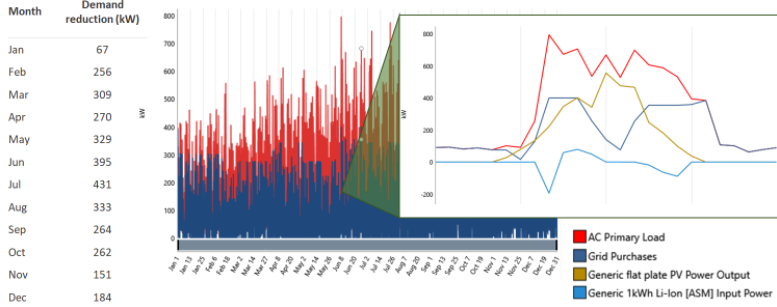
Director of Energy Engineering John Glassmire explains peak shaving and unveils the HOMER Demand Charge Reducer (DCR).*
HOMER Energy’s John Glassmire Giving Presentation on HOMER DRC at SPI
Peak shaving–the ability to control your utility electricity costs during periods of heavy electricity use–has been drawing increasing interest in the world of microgrids and distributed generation. For grid-connected commercial and industrial (C&I) customers, the demand charges associated with peaks in consumption during high-use periods can be substantial — up to 70% of the customer’s utility bill — and peak shaving is a great option to reduce these costs. In fact, a just-released National Renewable Energy Laboratory (NREL) survey of U.S. demand charges found that more than 25% of commercial utility customers (or about 5 million customers) in the U.S. alone would benefit from reducing peak demand consumption.
But how to model the potential savings and to ensure that a potential customer is a good candidate for a peak shaving investment? Until now, there have been limited tools to find the best microgrid and onsite generation solutions to maximize these bill savings. Meanwhile, organizations are paying millions more than they need to pay for their electricity.
HOMER Energy, developer of world-leading HOMER Pro software, has developed the Demand Charge Reducer (HOMER DCR) tool for this purpose. HOMER Director of Energy Engineering John Glassmire will present this solution at the Solar Power International (SPI) conference, which takes place September 10-13, 2017, in Las Vegas. John’s session, “Economic Analysis and Design Optimization for Peak Shaving Applications,” will take place at the SPI Technical Symposium Monday, September 11, 3:10 pm – 3:30 pm at the Mandalay Bay Convention Center, Ocean Side B, Las Vegas, Nevada.
Integrating solar/storage/backup systems to reduce peak demand
John will discuss the need for accurate tools to integrate storage with other onsite power sources and then to analyze microgrid options for peak shaving, arbitrage, grid backup, and renewable integration. He will detail how HOMER Energy’s new DCR tool addresses these needs with a novel new design optimization tool. The tool performs simulation and optimization analysis, enabling you to optimize a hybrid energy solution of solar, battery, and generators, so you can use clean technologies to reduce costs and increase reliability. It also allows you to perform sensitivity analysis so you can understand and quantify the robustness of a particular design choice. HOMER DCR performs these calculations with the click of a few buttons. The tool uses a web interface to connect with a HOMER’s SaaS API to enable designers, investors, and other interested parties to design a distributed solar/storage/back-up generation system.
John will also show some preliminary results from HOMER DCR. The figure below shows the impact that a solar+battery system could have for a commercial customer in California. The table below shows the potential demand reduction by month, while the charts include a red line that shows the customer’s load, and the dark blue line shows the power that was purchased from the utility. The difference between these is due to the on-site solar production (golden line) and the energy shifting from the batteries (light blue line). HOMER DCR intelligently balances the load and helps the user to determine the optimal size of both the solar PV and batteries.

HOMER DCR reduces costs for wide range of customers
“We found that the tool is capable of optimally sizing distributed generation and storage to reduce costs,” Glassmire explains. “It can also provide design options that will improve customer electrical reliability by providing backup to utility service failures. The tool is capable of automatically downloading utility tariffs and evaluating performance for a range of locations, and delivering geo-specific, realistic results. HOMER DCR is suitable to model a range of project types, from residential to commercial to industrial.”
Join John Glassmire and other solar industry leaders in Las Vegas next month! Go to SPI’s website for more information and to register for this event.
Related stories:
NREL: Using Stored Energy for Demand Charge Reduction Brings Significant Savings
Colorado multi-stakeholder Solar-plus-Storage “Portfolio” Microgrid Project
Texas School District Lowers Peak Demand Using Ice-Based Energy Storage
New Hampshire Electric Co-op’s New Demand Response Program Uses Smart-grid Technology
How Time-of-Use Pricing Can Enhance Grid Power and Consumer Choice
